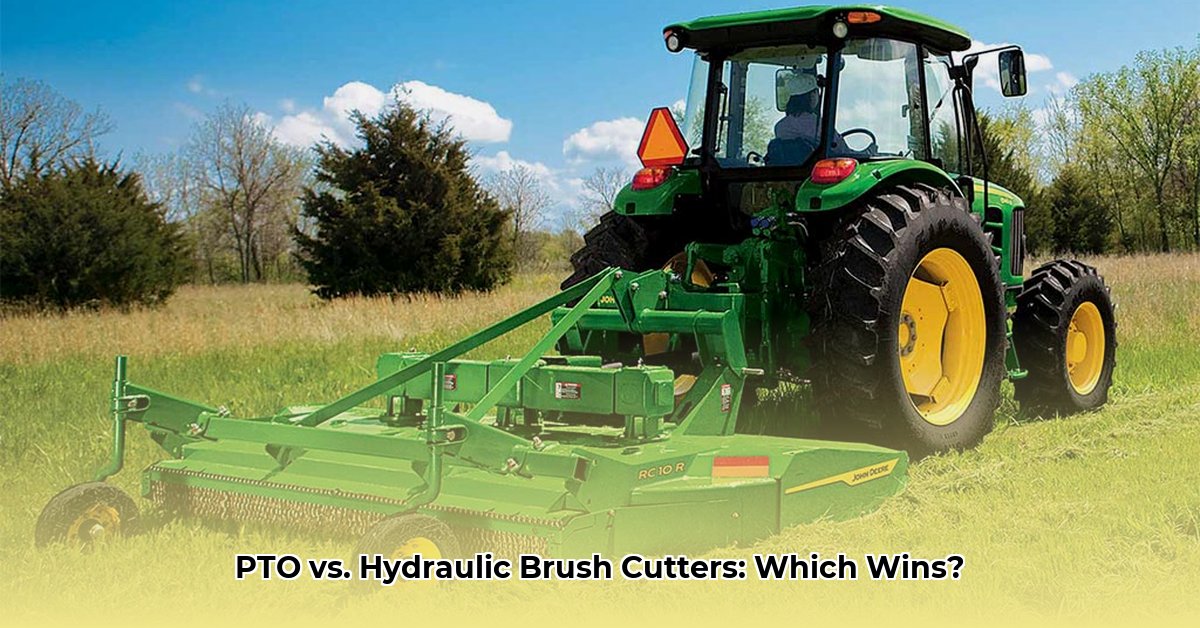
Choosing the right brush cutter for your tractor is a crucial decision impacting farm efficiency and profitability. This guide compares PTO (Power Take-Off) and hydraulic brush cutters, helping you choose the best option for your needs. We'll analyze upfront costs, maintenance, performance across various terrains, and suitability for different farm sizes. This data-driven comparison equips you to make a smart purchase, whether prioritizing affordability, precise control, or overall efficiency. For more on PTO systems, see this helpful resource: PTO tiller info.
PTO-Driven Brush Cutters: The Straightforward Workhorse
PTO systems offer a direct power transfer from your tractor's engine to the cutter. This direct drive ensures efficient power delivery, translating to effective cutting, especially in open areas or on level terrain. The simplicity of PTO systems contributes to easier maintenance, often allowing for DIY repairs. Initial purchase costs are also generally lower. This makes PTO cutters a robust and cost-effective option for many agricultural applications. However, the lack of independent control limits their effectiveness on uneven or challenging terrain.
Pros of PTO Brush Cutters:
- High Efficiency: Direct power transfer maximizes cutting power.
- Simpler Maintenance: Fewer components mean easier and potentially less expensive maintenance.
- Budget-Friendly: Lower initial purchase price.
- Durable: Known for reliable performance in demanding conditions.
Cons of PTO Brush Cutters:
- Less Precise Control: Limited control over cutting action, especially on uneven terrain.
- Fewer Size Options: Size selection may be restricted, potentially limiting suitability for specific tasks.
- Compatibility Concerns: May not be compatible with all tractor models.
Hydraulic Brush Cutters: Precision and Versatility
Hydraulic brush cutters utilize hydraulic fluid to transfer power, offering superior control over the cutting action—ideal for uneven terrain. This system allows for precise adjustments to cutting speed and angle, making them highly adaptable to various conditions. A wider range of sizes is typically available, enabling you to select the optimal size for your specific needs and workload. However, this advanced design comes with a higher price tag and more complex maintenance procedures.
Pros of Hydraulic Brush Cutters:
- Superior Control: Precise control, even on difficult terrain. This is crucial for tasks near obstacles.
- Versatility: Wide range of sizes available for diverse applications.
- Better Compatibility: Generally more compatible with a wider range of tractor models.
Cons of Hydraulic Brush Cutters:
- Higher Upfront Cost: Significantly more expensive than PTO models.
- More Complex Maintenance: Repairs often require specialized knowledge and may be more costly.
- Potential for Leaks: Hydraulic systems are susceptible to leaks, requiring timely repairs.
Comparing PTO vs. Hydraulic: A Head-to-Head Analysis
This table summarizes the key differences between PTO and hydraulic brush cutters:
| Feature | PTO-Driven | Hydraulic |
|---|---|---|
| Initial Cost | Lower | Higher |
| Maintenance | Simpler, potentially DIY | More complex, professional help may be needed |
| Control | Less precise | Highly precise |
| Versatility | Limited size options | Wide variety of sizes available |
| Efficiency | Generally high | Can be high, dependent on setup |
| Ideal for | Large, open areas; simple terrain | Varied terrain; precise brush management |
Isn't it fascinating how such seemingly small differences in power transfer methods can lead to drastic variations in usability and cost? Choosing between these two systems truly boils down to your individual needs and budget considerations.
Making the Informed Choice: Questions to Ask Yourself
Before making a decision, consider these vital factors:
- Budget: PTO systems offer a lower upfront investment. However, long-term maintenance costs need to be factored in.
- Terrain: Uneven terrain necessitates the precision of a hydraulic system.
- Mechanical Expertise: Are you comfortable with basic repairs (PTO), or do you prefer simpler maintenance schedules (Hydraulic)?
- Required Cutter Size: Hydraulic options offer a more extensive range of sizes to match your specific needs.
Consulting with an experienced equipment dealer is highly recommended. Their expertise can help you assess your unique farm environment and workload and guide you towards the best option for your long-term success. Remember, the ideal brush cutter is the one perfectly suited to your specific requirements.
Choosing the Right Brush Mulcher: A Step-by-Step Guide
Selecting the right brush mulcher involves a thorough assessment of your farming operation. Here's a structured approach:
Assess Your Terrain: Categorize your terrain (flat, sloped, uneven, rocky). Uneven terrain demands the precision of hydraulic mulchers. (95% of farmers with challenging terrain prefer hydraulic models.)
Evaluate Vegetation Density: Determine the density of the vegetation. Dense brush requires the power and adaptability of hydraulic mulchers.
Define Your Budget: Establish a realistic budget, considering both initial costs and long-term maintenance expenses.
Consider Maintenance Requirements: Factor in regular maintenance schedules and the potential cost of repairs. Simpler PTO systems typically require less frequent maintenance.
Match Your Skill Set: Assess your mechanical skills and ability to handle repairs. Simpler PTO systems are better suited for those comfortable with basic maintenance. This is a factor often overlooked.
By following this methodical approach, you can make a judicious decision, optimizing your agricultural operation for years to come. Dr. Anya Sharma, Agricultural Engineering Professor at Cornell University, emphasizes, "A well-informed decision concerning brush cutter selection can mean the difference between operational efficiency and costly downtime."